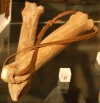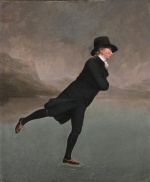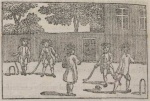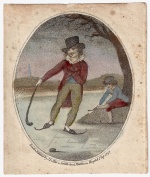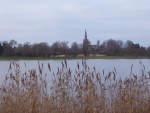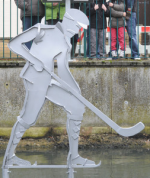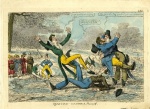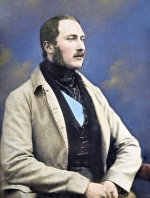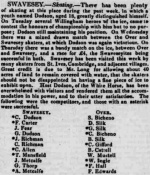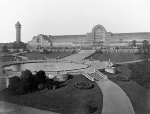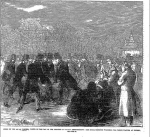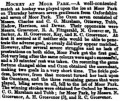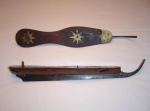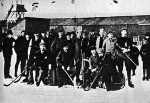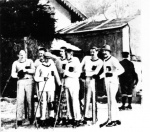Early British Ice Hockey
The origins, development, and history of ice hockey in Great Britain is long and complex. This article will overview many of the key events that led to the modern version of ice hockey we see today.
Terminology
- Bandy - a game played on the ice with curved sticks and a ball. Prior to 1900, the terms "bandy", "ice hockey", and "hockey on the ice" were all basically interchangeable in Europe.
- Bung - an early word for a puck. They could be made of wood, cork, or india rubber.
- Chamiare - another word for shinty.
- Hockey on the ice - another term for "bandy".
- Hurling - an Irish game played with wooden sticks and a ball.
- Shinty - a Scottish game played with sticks and a ball.
Timeline
This timeline concisely details some key dates in the development of hockey in Great Britain.[1]
- 1174 - First definitive mention of ice skating (with bone skates).
- 1607-1608 - Chamiare (shinty) was played on the ice at the Firth of Fourth in Scotland.
- 1662 - First documented use of iron skates in England.
- Circa 1713-1714 - The supposed start of the Bluntisham-Cum-Earith club's 100+ year unbeaten streak.
- 1740 - The first documentation of hurling being played on the ice in Ireland.
- 1773 - The first contemporary use of the word "hockey" (referring to field hockey).
- 1797 - First documented use of a bung/puck. The oldest contemporary evidence of a puck/bung being used on the ice is the Joseph Le Petit engraving from 1797 (London).
- 1813-1814 - First documented matches played in the Fens. Legend had it that Bluntisham-Cum-Earith had been undefeated for a century.
- 1816 - First newspaper account of bandy being played on the ice. It was in Chester, England.
- 1822 - First use of the word hockey on ice. Previous references to shinty, bandy and hurling being played on the ice exist, but the first contemporary reference to hockey being played on the ice comes from 1822, when the drowning of Fred Leatherbarrow in St. James’s Park in London was reported.
- 1827/1858 - First use of a referee/official. Richard Brown recounted to Charles Goodman Tebbutt many years later that he had been a referee as early as 1827. The first contemporary reference to referees came from George Frederick Pardon in the 1858 book Games for All Seasons. Pardon described the game on the ice with an umpire calling play.
- 1827/1871 - First identified goaltender. John Jackson from Earith played goaltender in 1827, according to interviews of participating players conducted by Charles Goodman Tebbutt many years later. The first contemporary reference of a goaltender is from 1871, when one of the Tebbutt brothers was in goal for a match played in Bury Fen.
- 1827/1871 - First identified captains. William Leeland was the first known captain in 1827. Once again, this was a recollection conveyed to Charles Goodman Tebbutt. The first contemporary reference of captains is from a game played on January 3, 1871 with William Meadows (Bluntisham) and Christopher Smith Billups (Chatteris) as captains of their respective sides.
- 1831 - First documented game planned in advance. The first such game was played on a field of ice in Colne Fen between nine-aside teams from Bluntisham and Colne on February 4, 1831.
- 1844 - First artificial (mechanically frozen) ice rink, known as the Glaciarium. It was not suitable for hockey playing, nor was the later rink of the same name that opened in 1876.
- 1847 - First stick manufacturer. John Owen Byles in London advertised hockey sticks in Bells Life in 1847. They were primarily made for field hockey, but undoubtedly could have been used for playing ice hockey too.
- 1850 - First recorded medical injury. In 1857, the Medical Chronicle published a clinical lecture by prominent London surgeon Dr. William Lawrence, who recalled an ice hockey-related injury that he had treated in England seven years earlier.
- 1857 - First hockey on the ice (bandy) game where the lineups of each team were included.
- 1868 - First written rules for ice hockey. In 1868 the Boy’s Own Book listed six rules, stating that "with a party of good skaters, this game affords fine sport, but of course can only be played on a sheet of ice of great extent."
- 1870 - First game with rosters and goalscorers. The ice hockey game between Spetchley and Worcester on December 27, 1870 is the first game with all players identified (ten aside), as well as the goalscorers. Spetchley won the game 4-3.
- 1871 - First documented assist in a game. Neville Goodman (Chatteris) in a game against Bluntisham.
- 1871 - First documented hat-trick. The seven-aside game between Moor Park and Oxfordshire on February 2, 1871 is the earliest known game where a player scored a hat-trick. Algernon Henry Grosvenor scored three goals for Moor Park, who won, 5-2.
- 1871 - First documented account of a timed game. In 1871, Elsham Club and Brigg Club played an eight-aside game were the time of the goals was noted.
- 1881 - First hockey skate. Skates were of course used to play hockey before this, but the "Standard Hockey Skates" were authorized to be used by the National Skating Association in 1881. They were manufactured in Sheffield by Colquhoun & Cadman and the Marsden Brothers and were the first specific ice hockey skates. They had the letters S.H. (Standard Hockey), upon the blade and upon the straps, they also had a symbol of two crossed sticks and a ball.
- 1883 - First rules published by an official governing body. The National Skating Association (NSA) published a set of rules. Separate rules were given for the Fens and theMetropolitan District (London).
- 1896 - First book written specifically about ice hockey. It was A Handbook of Bandy; or Hockey on the Ice by Arnold and Charles Goodman Tebutt. The book was published on January 15, 1896.
- 1896 - First game played indoors. A game between teams representing "England" and "Canada" was played at the Hengler's Ice Rink on February 1, 1896. "England" won 3-0.
- 1897 - First organized tournament. The New Niagara Challenge Cup was played at Niagara Ice Rink in March 1897.
- 1898 - First national champion crowned. This was Niagara Ice Hockey Club, who won the Admiral Maxse Challenge Cup.
- 1903-04 - English Ice Hockey League, the first league in Britain and all of Europe, was contested. It was won by the London Canadians.
- 1909-10 - The Scottish Ice Hockey Association is formed.
- 1910 - The British National Team wins the gold medal at the inaugural 1910 European Championship.
- 1913 - The British Ice Hockey Association is formed.
History
The first definitive mention of ice skating in Britain dates back to 1174, when it was noted that young men would "play vpon the yce" (play upon the ice) and tie "bones to their feete" (feet).[2] Various stick and ball games are also known to have been played on the ground over the next few centuries.
The Historie of the Kirk of Scotland was published by Scottish divine and historian David Calderwood (1575 - October 29, 1650) in an abridged form in 1646. A page in the book, discussing the "Great Frost" of the winter of 1607-1608, noted the following about the Firth of Fourth (using modern English): "The sea froze so far as it ebbed, and sundry went into ships upon ice and played at the chamiare a mile within the sea-mark." This is the first documented mention of a stick and ball game being played on the ice, although it is unknown if skates were used or not.
Skating became a popular activity in Britain during the 1700s. The first advertisement for skates for sale dates back to 1729, when the Daily Post in London published an ad for "Dutch Slideing Skates."[3]
Hurling is known to have been played on the ice in Ireland as early as 1740. Two quotes exist, the first from an unknown newspaper published in a book: "Accounts from Nenagh under date of Jan. 5th [1740] say:—'The Shannon is frozen over, and a hurling match has taken place upon it; and Mr. Parker had a sheep roast whole on the ice, with which he regaled the company who had assembled to witness the hurling match'…"[4] Another quote from the Dublin Evening Post notes that "Teams of gentlemen play match of hurling on the ice of the River Shannon near Portumna".[5] It is unknown whether skates were used for these games of hurling on the ice.
The Edinburgh Skating Club is recognized as the first organized figure skating club.[6][7][8] While some sources[6][9] claim the club was established in 1642, most sources accept 1742 or 1744 as the date of its founding. The next-oldest skating club, in London, was not founded until 1830.[6]
The claim to the 1642 founding date appears to derive from a small book published by the club council in 1865, The Edinburgh Skating-Club with Diagrams of Figures and a List of the Members. As of that writing, the club's oldest extant records were dated January 1778, and the reference to 1642 appeared only in club records from long after that period.[6] There was an early contemporary reference to the Club in the second edition (1783) of the Encyclopædia Britannica that supports the 1742 or 1744 founding date:
- The metropolis of Scotland has produced more instances of elegant skaters than perhaps any country whatever: and the institution of a skating club about 40 years ago has contributed not a little to the improvement of this elegant amusement.[6]
From this description and others, it is apparent that the form of skating practiced by club members was indeed an early form of figure skating rather than speed skating. For admission to the club, candidates had to pass a skating test where they performed a complete circle on either foot (e.g., a figure eight), and then jumped over first one hat, then two and three, placed over each other on the ice.[6] The favorite meeting place of club members was Duddingston Loch, near Edinburgh, Scotland. The principal object of the club was the practice of a form of choreographed group skating. The club also held an annual dinner where the standard dish served was "sheeps-heads and trotters",[6] perhaps in deference to the local Sheep Heid Inn in Duddingston. Today the club is best known for its association with the painting The Skating Minister by Henry Raeburn, more formally titled The Reverend Robert Walker Skating on Duddingston Loch.
Contemporary references to skating races date back to 1763. The January 8 issue of Berrow's Worcester Journal noted a "Sweepstake Skaiting Match" held on the 6th at the River Isis in Oxford.[10] The first documented skating races were also held in the Fens on January 27 and 28 of that year.[11] The first instructional book on skating, called A Treatise on Skating, was published in London by Captain Robert Jones in 1772. His book mostly discussed the art and majesty of figure skating, and its publication led to two distinct forms of skating emerging - figure and speed. Jones was convicted of sodomy in July 1772 and exiled from England.
The first contemporary use of the word "hockey" is from 1773. A chapter in a book called Juvenile Sports and Pastimes refers to "New Improvements on the Game of Hockey". The book noted that the game of "hockey" was likely derived from hurling and that only three objects were required to play; goals, hockey-sticks and the "hockey" (object to hit). The book was of course referring to field hockey, but does provide the earliest known reference to "hockey" being played.
George Penny wrote the following in a book published in 1836: "The Shinty or Club, used to be played in all weathers on the Inch; and frequently on the streets, by large assemblies of stout apprentices and boys. This game was also played on the ice by large parties, particularly by skaiters, when there was usually a keen contest."[12] The time period and location where the events he was referring to took place was Perth, Scotland, sometime between 1745 and 1809. It is important to note that an explicit reference was made to skates; absent from the 1607-08 and 1740 references to games played on the ice.
The earliest depiction of hockey being played on the ice with a bung is the engraving published by Joseph Le Petit in London on September 1, 1797. Although it wasn't published until 1797, the print appears to be referencing a scene that took place on the ice in London the previous December (1796). A quote by E.T. Sachs published around 1892-1896 in Young England - An Illustrated Magazine for Young People throughout the English-Speaking World, seems to remark on this print: ""In the old days, and to within quite recent years, the game was played with a bung. A couple of miles from where I am writing I found a small print of a youth on the ice on skates, with a hockey stick in the hand, and a bung lying on the ice at his feet. This print is more than a hundred years old [actually nearly 100 years old], which shows that our great-great-grandfathers knew how to enjoy themselves in the winter quite as well as we do."
The February 9, 1803, edition of the Aberdeen Journal referred to an accident that had occurred on the ice in Paisley, Scotland on the 5th: "On Saturday [Feb. 5], a most melancholy accident happened in the neighbourhood of Paisley —Two boys of about 14 years of age, the one named Ritchie, and the other Macallum were playing at shinty on the ice, at that part of the Cart called the High Lin, when the ice gave way with them, and they fell in, to the depth of 10 or 12 feet."[13] There was no mention of skates, however, but that does not preclude the possibility that they were used.
The first confirmed bandy match on skates in the Fens was played during the bitterly cold winter of 1813-14. "Hocky" on the ice was also played on the River Thames in London in 1814, as described by Dudley Costello in The February Winter: "The return from Kew to Richmond, not by the road but the river, no longer a 'silent highway', but a firm and compact mass of ice on which shouting thousands were in motion, skating, sliding, playing at football and hocky."[14]
The Fens, also known as the Fenland(s), is a naturally marshy region in eastern England. Most of the fens were drained several centuries ago, resulting in a flat, damp, low-lying agricultural region. The region was a hotbed for skating and bandy. The Fen lowland of Huntingdonshire often became overflowed, providing ideal ice for these activities during the winter months.
Charles Goodman Tebbutt published an article on bandy in a book entitled Skating in 1892.[15] In it he described the origin of bandy in the Fens. Relevant passages from the article is reproduced below for reference (for the full article, please see Skating (1892):
"Concurrently with skating races, bandy matches have long been held in the fens. It is certain that during the last century the game was played and even matches were held on Bury Fen, and the local tradition that the Bury Fenners had not been defeated for a century may not be an idle boast. But it was not until the great frost of 1813-14 that tradition gives place to certainty. I propose to furnish a short account of the Bury Fen players; for, excepting a few games played on private waters in different parts of England, bandy has been confined to that district, and its history is a history of the game.
When the army of Napoleon, retreating from Moscow [this was actually the winter of 1812- 1813], were starved and frozen to death by thousands; when, at home, Prof. Sedgwick had to burn his gun-case and chairs to keep himself warm; when the scarcity of coal at Cambridge was so great that the trees within the grounds of St. John's College were cut down for fuel, and in all the colleges, we are told, the men sat in their rooms two and three together for warmth; then the hardy watermen, gunners, and labourers were quickening their circulation by playing bandy on Bury Fen. It was then that that fine old Fenman, William Leeland, at the time scarcely eleven years old, remembers watching the matches and joining in the practice of bandy. Undoubtedly matches were played before this time, and Leeland had 'heard talk' of them; but we have no records…"
"[From about 1825] until well into 1850 Leeland captained the Bury Fenners, and only died in the autumn of 1891, in his ninetieth year [actually in his 87th]. An interview with this fine old player was made specially interesting by his pleasant memories of matches won at bandy..."
"[Of the players from the early part of the century] "only Mr. R. Brown (88), Jas. Searle (75), and Bill Christmas (71), still live at the time of writing (Christmas, 1891)…"
Tebbutt's writings state that bandy had likely been played in the Fens well before 1813-14, but that he could only confirm its existence beginning with that time period. The fact that he also gave some credence to the legend that Bluntisham-cum-Earith (also called the "Bury Fen" club and later Bury Fen Bandy Club) had been undefeated for a century, provides evidence that bandy was played in the Fens as far back as the early 1700s, if not even earlier. A statue of a bandy player was erected at the village pond of Earith to commemorate the 200th anniversary of the first documented game in 2013.[16]
The earliest known newspaper account of bandy being played on the ice in England comes from Chester, Chesire. This passage from the February 16, 1816, edition of the Chester Chronicle, reads the following: "Monday last [February 12], that part the River this city, distinguished the name of St. John's Dee, was crowded with skaiters sliders and bandy-players; and although no serious accidents occurred, several met with very severe tumbles."[17] There was no mention of skates being used by the "bandy players", but given the reference to "skaiters" earlier on in the passage, there was a good chance they were wearing them too.
A letter written by famous English scientist Charles Darwin (1809-1882) to his son, dated March 1, 1853, contains a fascinating quote: "Have you got a pretty good pond to skate on? I used to be very fond of playing at Hocky [sic] on the ice in skates." He probably learned to skate and play hockey as a young boy on the river Severn during the years he attended Shrewsbury School (1818-1825).[18]
A print from circa 1815-1820 (likely 1818) depicts three adults playing hockey on skates with a bung in the background, while some "dandies" have a humorous mishap on the ice in the foreground. It was done by Charles Williams and was entitled "Skaiting - Dandies, showing off." The British Museum describes that "Men in the distance skate with ease; some play hockey with sticks and a cork."
The first contemporary reference noting "hockey" being played on the ice is from the December 30, 1822, issue of The Times, when the drowning of Fred Leatherbarrow in St. James’s Park in London was reported. The paper noted that, on the 27th, "Friday, about two o'clock, the canal being well frozen over, a great number of persons were assembled on it, some amusing themselves in skating, others sliding... A respectable youth of the name of Leatherbarrow, was amusing himself with fetching a bung to play at hockey, on a sheet of ice in St. James’s-park, which was not bearable."[19] It is unclear if Leatherbarrow was wearing skates or not.
The December 31, 1829, edition of The Morning Post (London) discusses skating and other activities taking place on the Serpentine River in London. "Hundreds of men and boys, principally of the lowest class, were pursuing the game of hockey, namely, striking a bung with a knobbed stick. As usual, many laughable scenes arose from parties coming in contact, and some falls were the consequence. This sport, however, is a terrible nuisance to the genteel portion of the visitors." Previously, a January 26, 1827, edition of The Morning Post, mentioned the lower orders were playing "hocky" on the Serpentine.
The Book of the Club of True Highlanders, published in London in 1880, described the game of shinty on the ice in the Highlands of Scotland: "when played on ice is one of the most exciting it is possible to conceive; the ball however, is replaced by a lump of cork, or bung, and the players wear skates."[20] This could have been as far back as 1830.
A a nine-aside bandy match on the ice was played at Colne Fen between Bluntisham and Colne on January 28, 1831, as reported by the February 5 edition of the Huntingdon Bedford and Peterborough Gazette.[21] It was the earliest contemporary reference to an organized stick and ball match on skates
The February 16, 1838, edition of the Lincolnshire Chronicle noted that a "warmly contested game at hockey" had taken place at the Croxby Pond in Lincolnshire (northeast England) on February 3.[22]
The Argus, London newspaper noted, on January 17, 1841, that Prince Albert of Saxe-Coburg and Gotha, husband of Queen Victoria, had been sent a "gold hockey stick" for use on the ice: ""It is suggested, that, as Prince Albert has at length found an arena for various signal instances of domestic courage, he add to his coat of arms (or, as Pat once said, the arms of his coat) a sledge proper argent, with a skate volant gules, in a field of ice powdered.
THE Golf Club, hearing of Prince Albert's hurling feats on the ice, have sent him a gold hockey stick, as a companion to the toy-skate, and to be worn on the opposite button-hole. He is said to be the most elegant Block in the country. Frogmore Lake is in future to be called Prince Albert's Own." Prince Albert was the first member of the Royal family known to have been interested in hockey on the ice.[23]
Eleanor Julian Stanley (1821-1903) became the Maid of Honour to Queen Victoria in 1842. On December 16, 1844, she wrote a letter to her mother, which was later published in a book. It discussed the royals skating and hockey activities at the aforementioned Frogmore: "Yesterday, as the pond at Frogmore was still frozen enough to bear skating upon, though in some parts the water was six inches deep over the ice, we all went with the Royalty to enjoy the pleasing diversion of standing at the edge, on the wet grass, looking at the gentlemen skating and playing at Hockey; I don't know whether it is right spelt, but it is a game played with a ball and crooked sticks; after this had lasted a good while, and it was too dark to go on playing, we all walked home through the grounds of the Castle, having first partaken of the Duchess of Kent's hospitality in the shape of mulled claret and biscuits."[24]
Another reference from the John Bull magazine, dated January 2, 1847, describes Prince Albert again having partaken in ice hockey at Frogmore, on December 31 of the prior year. ""On Thursday after breakfast, Her Majesty and her distinguished visitors rode to Frogmore, where the ice on the lake was considered to be of sufficient thickness to justify the Prince and his attendants to venture on the ice. The Queen, with the Duchess of Sutherland, the Marchioness of Douro, and the Hon. Miss Paget, in the meanwhile, promenading on the banks of the lake, while the exercise of skating was being enjoyed by the remainder of the Royal party. Afterwards a game at 'Hockey' on the lake was proposed by the Prince Consort, which was participated in by the whole of the gentlemen present. Sides were chosen; and, after an excellent trial of skill, which lasted upwards of half an hour, Prince Albert, and the players on the side of his Royal Highness, came off the victors. Her Majesty appeared to be exceedingly amused during the progress of the game. Her Majesty and the whole Court returned to the Castle to lunch between two and three o'clock."[25]
George "Cyclos" Anderson wrote a book entitled The Art of Skating that was published in Glasgow in 1852. In it he described the game of shinty on the ice in Scotland. "Where there is room, I consider following the shinty ball on skates an exhilerating [sic] and invigorating pastime; and, what is still more to the purpose, I know no other sort of practice that will give a learner so much confidence and security on skates.
Of course he must be able to run about pretty freely before he can attempt shinty, but when he can, the keen spirit of the game, urging him after the ball, with rapid runs, sudden stops, and quick turns, quite heedless of falls and impediments, will give him control over his skates that twice as much less exciting practice would not. Sharp heeled skates are a great advantage in this sort of skating."
In 1857, the Medical Chronicle published a clinical lecture by prominent London surgeon Dr. William Lawrence, who recalled an ice hockey-related injury that he had treated in England seven years earlier. "In the winter of 1850, it appears, the patient was playing on the ice; while engaged in some game, the precise nature of which I do not understand, and termed 'hocky' -- a game, as I learn (and you will correct me if I'm wrong,) where there is hard hitting of a ball, or hard hitting of a hard ball, which struck the side of the leg, or tibia, of this poor young man. He says he did not make anything of it at the time, nor did he interrupt his playing; he even went on in the excitement of the game till he unluckily got a second blow, but this time with the 'hocky' stick, on the identical same spot."
In Sir John Dugdale Astley's Fifty Years of My Life in the World of Sport at Home and Abroad, he recalled playing hockey on the ice below the terrace of Windsor Castle with Prince Albert and some other British officers in December 1853. The Prince played goaltender for one side, while Lord Listowel (William Hare, 2nd Earl of Listowel), kept goal for the other team. Queen Victoria watched the game intently. In the same publication, Astley mentioned playing hockey at Oxford in late 1846: "My first term at Oxford was remarkable for the very heavy floods. The Thames overflowed all the meadows for miles, and while the water was still out there was a severe frost, which produced some first class ice. We had some real good hockey - one of the best games, in my humble opinion, that man can play."
A woodcut drawing titled "The Thames frozen over at Richmond" was included in the March 3, 1855, edition of The Illustrated London News. In it some gentlemen can be scene partaking in a game of ice hockey at the foreground.[26] An 1855 report from the Exeter and Plymouth Gazette (Exeter, Devonshire) mentioned that the Exe river and been frozen for over two weeks and that "Hundreds of persons have been continually skating on it, and two or three days parties have played sundry games of hockey, &c., upon the ice."
A bandy match was staged at Mere Fen between the villages of Swavesey and Over on February 5, 1857. The match was held concurrently with skating races. Swavesey won both the bandy game and the races. The individuals listed as competing for Swavesey and Over participated in both events.[27]This is the earliest contemporary reference to list the complete lineups of each team.
On December 22, 1859, the Devizes and Wiltshire Gazette reported a hockey match had taken place on Bowood Lake in Calne, located in southern England, on the 19th. "Bowood Lake – On Monday and Tuesday this picturesque lake was one scene of animation, from the number of gentlemen who had assembled to enjoy a day's skating and a jolly good game at hockey, in which Lord Shelburne showed himself no novice in the handling of his golf.
Sides were chosen, which were distinguished by pink and yellow ribbons worn on the arm, and in a very short time the shinty, which was painted red, began to dance over the ice right merrily, sometimes flying through the air and at others coming most unceremoniously against one's shins with a smart crack. The goals were denoted by pink flags at one end and yellow at the other. Both parties were victorious in their turns." The sticks were called the "golf" and the ball the "shinty".[28]
Another reference to Royal hockey comes from the February 18, 1860, edition of Jackson's Oxford Journal. Albert Edward, Princes of Wales (later King Edward VII), the son of Queen Victoria and Prince Albert of Saxe-Coburg and Gotha, was noted to have "skated for some hours on Long Meadow, and appeared much to enjoy the game of 'bung and hockey', entering as he did into competition with all engaged in the same pursuit, and delighting every one with his affability."[29] The Prince of Wales had definitely inherited his father's love of ice hockey, as future references will expand upon.
A Handbook of Bandy; or, Hockey on the Ice, edited by Arnold Tebbutt (Charles Goodman's brother, who wrote the chapter on bandy in the previously mentioned Skating publication), was the very first book to be published on the sport when it came out in 1896. It contained many important references and anecdotes that help provide a clearer picture on the activities taking place around the country, especially in the Fens. In the book it was recounted that in December 1860, Neville Goodman (Arnold's uncle) and Charles Prentice Tebbutt (his father) of the Bluntisham-cum-Earith (Bury Fen) club, came from their native Fens to visit London. While visiting they demonstrated hockey on the ice (in the way it was played in the Fens) at the Crystal Palace on December 27.[30] A later report of hockey being played on the Crystal Palace lake comes from the December 26, 1870, issue of The Times, London: "The large sheet of ice on the boating lake was covered with skaters, some playing hockey..." The Crystal Palace was a cast-iron and plate-glass structure originally built in Hyde Park, London, England, to house the Great Exhibition of 1851.
On January 12, 1861, Jackson's Oxford Journal reported that the Eight Berks Rifles, situated in Faringdon, Oxfordshire, two days earlier, had "adjourned, skates in hand, to the fish pond in the park, where a very spirited game at hockey was joined in by all present."[31] At the time it was a common practice for British troops to have skates with them, so it should be of no surprise that informal games of hockey sometimes took place.
The 1892 Skating book, with the chapter on bandy by Charles Goodman Tebbutt, is once again revisited here. Tebbutt wrote that "in 1864, a Hartfield eight played a Hoddesdon eight at Brockett Hall Park."[15] This was in Hertfordshire. The Prince of Wales' hockey activities were again reported on at Virginia Water Lake in Berkshire on January 9, 1864. The Virginia Water Lake was a long-time hotbed for hockey playing. This rather lengthy report comes from The Times, London newspaper:
Her Royal Highness watching the Prince playing at Hockey "Yesterday was a grand day on the ice at Virginia Water. His Royal Highness, the Prince of Wales left Frogmore Lodge at a quarter past 11 o’clock in the forenoon, in an open carriage and pair, with several gentlemen of his suite, and arrived at Virginia Water shortly before 12 o’clock. Her Royal Highness the Princess of Wales followed in a close carriage, accompanied by her ladies in attendance.
Their Royal Highnesses immediately proceeded to the lake, where they were met on the ice by about 40 ladies and gentlemen, many of the gentlemen belonging to the London Skating Club.
Two sides were chosen for the game of hockey. Those on the Prince’s side were distinguished by a white riband on the left arm. The game was kept up with great animation until 2 o’clock, when the Prince and his companions repaired to the Fishing Temple, where they partook of a sumptuous luncheon.
Afterwards they returned to the lake and resumed the game of hockey, which they kept up until a quarter to 5 o’clock, when the Prince left for Frogmore. His Royal Highness proved himself a first-rate skater and player, being as active with his hockey stick as he was on his skates, puzzling many of the most expert players.
Her Royal Highness the Princess of Wales, who is an excellent skater, seemed much interested in the game, and was occasionally driven about in a sledge. The Princess left Virginia Water at 4 o’clock. Besides the Royal visitors and suite, there were upwards of 500 people present, including a large number of ladies, who displayed much skill and grace in the performance of several difficult figures.
This exciting scene was much enlivened by the performances of the band of the Royal Horse Guards (Blue), who were comfortably seated round a large charcoal fire on the banks of the lake, near to the Fishing Temple."
The first ever published rules for ice hockey date back to 1868, when a list of six rules were included in the Boy's Own Book, a popular British anthology of games and sports. The rules obviously applied to field hockey too, but could definitely be adapted for playing on the ice. Two quotes describing the sport of "Hockey" featured in the book highlight this: "Hockey is a fine amusement for all seasons-in the summer on the turf, in the winter on the ice" and "With a party of good skaters, this game affords fine sport, but of course can only be played on a sheet of ice of great extent".
There were games played at Wickham Market in Suffolk, in the Fens at Mere Fen, Swavesey in February 1870. The winter of 1870-71 was a very busy time for ice hockey in England. The most important event took place on December 27, 1870, at Spetchley Park, Worcestershire. The match, played 10-aside, won 4-3 by Spetchley over Worcester, is notable as it was the first match to have the lineups and goalscorers reported. The Worcester Chronicle and Bell's Life in London and Sporting Chronicle both offered detailed reports of the game.[32][33] On January 13, 1871, the Stamford Mercury reported on a game that had been played at Elsham, Lincolnshire, a week earlier: ""At Elsham Hall ponds on Friday last a party of gentlemen got up a skating match between eight of Brigg and eight of Elsham, the inspiriting game being hockey on the ice. Colonel Astley, a thorough lover of sport, kindly invited a party from Brigg to a contest with the village folk. The play went on for an hour and a half, and the result was a drawn game. After the struggle was over the combatants were entertained in the finishing course with good refreshment."
The Morning Post reported, on February 4, 1871, that two days prior (Feb. 2), a match had been played at Moor Park, Hertfordshire, between Moor Park and Oxfordshire. Moor Park was victorious, 5-2. The first game where the timing of all goals was reported was played at Elshalm Hall on February 4, 1871 (note that a previous match had taken place there about a month earlier), where the Elshalm Club defeated the Brigg Club 8-0. It was reported in the February 10 issue of The Hull Packet and East Riding Times.
There was a lot of activity in the Fens this year as well. A report from the December 28, 1870, edition of The Cambridge Independent Press mentions that a 16-aside a game of "bandy or hockey" was played in Earith between Bluntisham-cum-Earith and Over and Swavesey. A later report from the January 7 edition of The Penny Illustrated Paper noted that a 20-aside match had been played between Bluntisham-cum-Earith and Swavesey on January 4, with the former winning 2-0. It is possible that this was the same match as the one reported to be held on December 28, with an error having been made in specifying the dates and number of players on each side. On January 14, 1871, Bell's Life in London reported that two bandy (hockey on the ice) matches had been played in the Fens on the 10th. Owing to a misunderstanding, two teams - Swavesey and Chatteris - showed up to face Bluntisham-cum-Earith. As told by Charles Goodman Tebbutt in Skating (1892), "During 1868 [1871] so strong were the Bury Fen players that when through a misunderstanding two teams, Swavesey with Over, and Chatteris, arrived to play, Mr. Meadows chose one Bury Fen team, and Mr. Tebbutt another, and they defeated both the visiting teams. One of the Chatteris team, a very big man, lay down, blocking the goal from post to post for all balls that kept on the ice."
- 1870-71 newspaper references
Another important development took place in 1873. This was the foundation of the Virginia Water Hockey Club, the first organized (dedicated specifically to playing hockey) club in the Metropolitan (London) area. Hockey had been played in the London area for many years (note the 1797 London engraving, the various activities involving the Royal family, and the visit paid by Charles Prentice Tebbutt and Neville Goodman Tebbutt in 1860, among others), but not on a particularly organized basis. They played at the Virginia Water Lake in Berkshire, which had previously been used by the Royal family and Eton College students for hockey activities.
Harold Blackett formed the Virginia Water club and was a key propagator of hockey in England for many years. The club played with a light straight or slightly curved ash stick and a flat brewer's bung covered with leather. These were closer to modern sticks and pucks than the curved sticks and balls used in the Fens, and the Virginia Water Club can rightfully be called the very first "modern" ice hockey team in the world.
The winter of 1878-79 was a cold one and lots of hockey was played in England. Another ice hockey game is recorded to have been played at Elshalm Hall in Lincolnshire on December 13, 1878, between the Elshalm Wanderers and Brigg. Elsham won, 5-0. Here is a quote from the December 21, 1878, edition of The Sporting Gazette:
"The severe weather we have experienced during the week has made the ice fairly safe for skating. On Friday, the 13th inst., a good game at hockey between eleven residents from Brigg and an equal number of Elsham Wanderers was witnessed on the ponds of Sir J. D. Astley, M.P., of Elsham Hall, the banks of which were honoured with a good sprinkling of the fair sex. The game commenced slightly in favour of Brigg, but the Wanderers, under the captaincy of F. Astley, Esq, getting warm to their work, soon placed the verdict beyond doubt, two goals being secured in half an hour. When half time was called a change of goals occurred. The Brigg team with varied and strenuous attempts vainly endeavoured to lower the Elsham standard, a very pleasant game terminating at call of 'time' in an easy victory for the home team by five goals to nil. A few slight casualties occurred during the game, but none serious. The warriors from Brigg, if not honoured with success, bore home with them reminiscences of valour by slight duckings and varied bruises to crown them with glory for wiser, if not better, men.
Appended is a list of players:
Elsham: F. Astley, Esq. (captain), Rev. R. C. Casson, H. Cartwright, R. Davy, F. Dunn, W. Hill, J. Marshall, J. Phillips, E. Spencer, G. Varley, and H. Waters.
Brigg: J. Andrews (captain), J. Baker, F. Heneage, W. Knight, E. Sandall, J. Shirtcliffe, T. Smith, J. Spight, S. Walker, W. Blackeye, and G. Strong."
Only 10 days later, on December 23, 1878, a second game was played at Elshalm Hall between Elshalm and Lincoln. Elshalm was victorious, 2-0. The quote from The Hull Packet and East Riding Times is as follows: "Elsham v. Lincoln – This match was played on the lake at Elsham on the 23rd instant. The Lincoln men brought down a strong team, and as the respective elevens were skating about prior to the commencement of the game, so active did the Lincoln men appear that long odds were betted on their eventual success. At three o'clock the captains, Messrs. Astley and Sibthorpe, hit off from the middle, Mr. Astley getting the ball away, the first omen of success for Elsham. The home team followed up in a body, and for the first twenty minutes the ball was kept entirely in the Lincoln half of the pond, and at last from a loose scrimmage was forced between the posts. After starting again the game was more even, both sides making some good runs, in fact the ball was at one moment at one end of the water, and almost before one could turn round it was shot up to the other end. After three-quarters of an hour's play ends were changed, and in a few minutes success again crowned the efforts of the home team, after a good run by Messrs. Marshall and Davy. No further goals were gained, though the Elsham men again forced the ball through their opponent's post. The goal was disallowed on the ground that it had been out of play, thus Elsham winning by two goals to nothing."
A match was played at Mere Fen, Swavesey, between Swavesey and Bluntisham-cum-Earith on January 22, 1879. The match ended in a scoreless draw, as reported by Bell's Life in London on January 25. The winters of 1879-1883 were busy ones in the Fens. One of the most important matches staged in the Fens, circa 1879-1882, was between Bluntisham-cum-Earith and Huntingdon St. Ilves. As told by Charles Goodman Tebbutt in Skating (1892), "The series of cold winters beginning with 1879 made Bury Fen lively with bandy and bandy matches, Mr. Sidney Tebbutt generally captaining the team. Matches and return matches were played with Swavesey, Chatteris, St. Ives, Huntingdon and Godmanchester at Mare Fen, Hertford, Houghton, and on Bury Fen. Still the Fenners maintained their credit for an unbeaten record.
The most important of these games, including the best players of the neighbourhood, was against Huntingdon and St. Ives, captained by Mr. Henry Goodman. The home team [Bluntisham-cum-Earith] won three goals to one, C. G. Tebbutt scoring two; F. Jewson, one; and J. Goodman, the Hunts goal. The size of ground used was about one hundred and fifty to two hundred yards long, by one hundred to one hundred and fifty yards wide."
There was a match played at Bury Fen in Bluntisham-cum-Earith between "Country" and "Town" teams on December 12, 1882. A report from The Daily News from the next day: "- At the Bury Fen meeting yesterday a hockey match on the ice was played between the town and country, resulting in a victory for the latter by four goals to nil." The "meeting" referred to was one of the National Skating Association.
The "Radcliffe Club" in Radcliffe-on-Trent, Nottinghamshire, attempted to arrange a match of hockey on the ice when they placed an ad with the Nottingham Evening Post on January 29, 1879. It is unknown if they found a suitable opponent, as no matches involving them were subsequently reported. The February 1, 1879, edition of the Worcester Journal noted that a hockey game had been played at Spetchley Park between Spetchley and "visitors". It was won by Spetchley. The Virginia Water Club is known to have played its first recorded game in 1879, as told by Neville Tebbutt in A Handbook of Bandy; or, Hockey on the Ice: "The first recorded match was played in 1879, on Virginia Water, against an Oxford team captained by the Rev. C. de Salis." The Magdallen College School and Magdallen College (Oxford University) played two matches against one another on February 1 and 5, 1879. The former won both by respective scores of 4-1 and 12-4.
- 1878-79 newspaper references
The Handbook of Fen Skating was written by the brothers Neville and Albert Goodman. It was printed in December 1881 and published in January 1882. Albert wrote a chapter on "Hockey", which included diagrams of the preferred sticks and player positionings used in the Fens. Illustration of skates approved by the National Skating Association (founded in 1879 with the aim of regulating the sport of fen skating) on October 14, 1881, for both regular skating ("Standard Running Skates") and hockey ("Standard Hockey Skates") were included. The skates were marked S.R. and S.H., respectively. An appendix was added, featuring the first codified rules for hockey on the ice in Britain. They were the rules of the Bluntisham and Earith Skating Hockey Club (later known as the Bury Fen Bandy Club), by Messrs. Frederick Jewson and Arnold Tebbutt. Informal rules had of course been published by the Boy's Own Book in 1868, but they were not codified as these were.
- Handbook of Fen Skating images
The National Skating Association published the first "official" rules for hockey on the ice in Britain on November 21, 1883. Previously a set of rules adhered to by the Bluntisham and Earith Skating Hockey Club had appeared in the Handbook of Fen Skating, published in January. The NSA included two different sets of rules - one for the sport "As played in the Fens" and another "As played in the Metropolitan District" (London area). The rules in the Fens, although not codified until 1882, had developed for a long time as the area had been the epicenter of organized bandy in England, with the first confirmed matches dating back to 1813-14 (although the sport had supposedly been played there for over a century before). Hockey in the London area had deep roots too, but it was not played on an organized basis until the foundation of the Virginia Water Club in 1873. The game in this region was based on various field hockey rules written by the Blackheath Hockey Club (early 1860s), Eton College (1868) and the Field Hockey Association (1875). See the article on the National Skating Association for a list of the rules.
James Muir, a Scottish-born journalist, wrote an article in the April 10, 1930, edition of the Toronto Globe, entitled "Hockey Played in Scotland Over Forty Years Ago". In the article he mentioned that Canadians, most of whom hailed from the Maritimes, attending Edinburgh University, played ice hockey while attending the school, and that the term "hockey" was older than many in Canada thought. "It was used by Canadian students attending Edinburgh University in the late eighties [1880s]. I saw them play." This is the first documented reference of Canadians playing ice hockey in Europe. Muir also noted that he played "hockey on the ice on skates" when he was a boy and that it was simply called "hockey". In addition, he mentioned having seen hockey games played at the Duddingston Loch near Edinburgh and on the ponds on Braid Hills, during the late 1880s and early 1890s.[34]
A match of tremendous importance was contested between a London Combination (officially called the Virginia Water Team, from which most of the players hailed) and the Bury Fen Bandy Club on January 22, 1891. It was played at Virginia Water and marked the first time that the Bury Fen squad left their native Fens to face a team from elsewhere in England. The club had been in the Netherlands earlier in the month, where they introduced bandy to the Dutch. This match was significant as it was the first time that the two contrasting styles of play were evaluated side-by-side. The NSA had issued two sets of rules for hockey playing in 1883, and the Fen players strictly adhered to the regulations. In London, the "Metropolitan District" rules were interpreted a fair bit more loosely. Many games were still played using the traditional flat brewer's bung covered with leather, instead of the recommended india-rubber ball. Virginia Water won the match 8-3, handing Bury Fen their first ever recorded defeat. London rules were used in the first half, while Fen rules were utilized in the second. For more information on this legendary game, please see the specific match report.
This match led to the formation of the National Bandy Association the following month. A unified set of rules were agreed upon shortly thereafter, and it was decided that a ball and not a bung should be used throughout the country. The Virginia Water players had greatly preferred playing with a ball to their traditional flat brewer's bung when it was utilized for the second half of their match against Bury Fen. The formation of the Bandy Association and retiring of the bung was one of the first divergences between bandy/hockey on the ice and modern ice hockey with a puck, which would re-appear at indoor rinks in England a few years later.
By the winter of 1894-95, there were over 20 active bandy clubs around England. It was a cold winter so there was lots of activity around Britain (see 1894-95 in British hockey for more details). There were no fewer than five games played at Buckingham Palace during January and February 1895. The most notable was a game between a "Palace" team and a "Stanley family" team, which was comprised of Frederick Arthur Stanley and his four sons. The game was played with bandy sticks and a puck. The Prince of Wales (later King Edward VII), still a great hockey lover and now in his mid-50s, was a participant in many of the games played on the palace grounds. The first confirmed Varsity Match between Oxford and Cambridge was also played this year (although there had supposedly been a match between the two sides in St. Moritz 10 years earlier). Hockey was also played in Belfast and Dublin in Ireland, and in Scotland and Wales.
The opening of three indoor ice rinks in London (Niagara Ice Rink, Hengler's Ice Rink, and Prince's Skating Club) and the Glasgow Real Ice Skating Palace in Scotland between 1895 and 1896 completely changed the complexion of the game in Britain. The first games to be played indoors were at Hengler's on February 1 and 6, 1896. A team representing England defeated the favored "Canada" in both games - 3-0 and 4-2. Although the nationalities of all the players is unclear, these games could probably be called the first "international" matches ever played. George Meagher, who had previously organized ice hockey practices at the rink a month earlier, played for Canada. The teams were as follows: Canada - Hancock, Meagher, S.B. Cooper, Stanton, Owen, and Hon. Algernon Grosvenor. England - Hebert, W.B. Cooper, Tyler, White, Davidson, and Hick.
Meagher, who was a tireless hockey propagator throughout Europe, was also instrumental in arranging a four game series between the London Bandy Club and a Glasgow team at the Real Ice Skating Palace between June 6-8, 1896. The London team won all four games, played with a puck, that could be considered a primitive form of ice hockey. The first ever tournament, known as the New Niagara Challenge Cup, was played at the Niagara rink in March 1897. The fickle climate had previously prevented any tournaments or league systems from being established for the outdoor game. Of note, the Virginia Water Hockey Club won the tournament, and another team that had played outdoor bandy in the past, Camberley, also participated. The two sports, while starting to evolve in their own directions, were still very much inter-connected.
Princes Ice Hockey Club was founded in late 1896 when Admiral Maxse granted Major Peter Patton permission to form an ice hockey team based at Prince's Skating Club in Hammersmith. Their first match was against Fenwick's team on February 13, 1897. Princes won, 6-3. Princes played against Hockey Club de Paris in Paris in a match using hockey sticks and a puck in December 1897. That same month, the Scottish Ice Hockey Club, captained by William Pollock Wylie, also played six games in Paris against local opposition. The first English Club Championship for the Admiral Maxse Challenge Cup in ice hockey was won by the Niagara Ice Hockey Club in April 1898. The first official Ice Hockey Varsity Match was played at Princes Skating Club in 1900. At Oxford's insistence, bandy sticks and a lacrosse ball were used. The following year, the team's played with hockey sticks and a puck.
The London Canadians, composed of expatriate Canadians, were formed at Prince's Skating Club in late 1902. According to Peter Patton in his 1936 Ice Hockey book, "they taught us hockey". A more modern version of the sport was slowly emerging. The English Ice Hockey League, the first league competition to be played in England and Europe as a whole, was staged in 1903-04 and won by the Canadians.
Meanwhile outdoor bandy in England was slowly dying. The influx of indoor rinks where ice hockey could be played, without being reliant on the weather, and increasingly warmer winters led to its demise. The famous Bury Fen Bandy Club, who had records of documented matches going back to 1813-14, shut down around 1901. The Virginia Water Hockey Club was listed as an "Open-Air Bandy Club" in 1901, but no further records of the club's existence are known. Modern ice hockey had officially usurped bandy.
The London Canadians played their last match on November 26, 1904, defeating Princes, before the club dissolved. A new team composed primarily of Canadian students from Oxford University attending with a Rhodes Scholarship, known as the Oxford Canadians, was formed in 1906. A great rivalry emerged between them and Princes, with the Maxse Cup for the English Championship flip-flopping between the two sides up until World War I.
After the closure of the Real Ice Skating Palace in 1897, Scotland did not get another indoor rink until the Crossmyloof Ice Rink opened in 1907. A small "house league" competition had begun at the facility by 1909-10 and the Scottish Ice Hockey Association was founded around the same time by theBeavers, Corinthians, King's, Star, and Wanderers clubs. Shortly after its foundation, the SIHA accepted an invitation to play Princes Ice Hockey Club in London. The fixture was played on March 26, 1910. This was the first international match between the two countries, and ended 11-1 in favor of the English side. A return match was played in Scotland in December, and the Scots recorded a surprising 8-3 victory.
The British National Team (playing as Princes Ice Hockey Club) made its international debut at the 1909 Coupe de Chamonix, which they won. Represented again by Princes, Great Britain became the first-ever European champion, winning the 1910 tournament staged in Les Avants. The Oxford Canadians were also present at the tournament, playing "out of competition". They defeated all three of the other European teams, but did not face Princes (Britain). Britain did not compete in the European Championships again until 1926, but they did claim the prestigious 1914 LIHG Championship.
The British Ice Hockey Association (BIHA) was founded in 1913 and was the governing body of ice hockey in England during the 1913–14 season. Prior to this point, the National Skating Association had served as the governing body of ice hockey in England, in a semi-official capacity, along with Princes Ice Hockey Club. World War I put an end to hockey in Britain, and the sport was slow to recover after the war.
Conclusion
So what is to make of all this? References of stick and ball games being played on the ice in Britain date back to the winter of 1607-08. These became more common in the early 1800s, with references to accidents (players drowning after falling through the ice usually), such as the 1803 report from Aberdeen and the 1822 drowning of Fred Leatherbarrow in London, and other reports of informal games (1814 - London, 1816 - Chester, Charles Darwin's correspondence). The 1797 Joseph Le Petit engraving of ice hockey being played with a bung in London and the 1818 piece involving the "Dandies" with gentlemen playing hockey in the background are also worth noting. It can, however, undoubtedly be said that the Fens were the "cradle" of early British bandy/hockey.
The first documented games in the Fens were played in 1813-14, and by that point legends of the Bluntisham-cum-Earith (Bury Fen) club having been unbeaten for a century had already become prominent. It seems highly likely that hockey was played in the Fens dating back to the early 1700s, at least. In fact, the Fens was the only place where the sport was played regularly at an organized level until the formation of the Virginia Water Hockey Club just outside of London in 1873.
Of course organized ice hockey had been played in other areas of Britain long before 1873. The 1838 Croxby Pond game, various references to the Royal family's hockey activities dating back to 1841, the 1859 Bowood Lake game, the 1864 Brocket Hall Park game, and various matches played during the winter of 1870-71 all demonstrate this. But it was only with Virginia Water's formation that hockey was played consistently by a club devoted to the sport outside of the Fens. As they played with ash sticks and a bung until 1891, Virginia Water can rightfully be called the first "modern" ice hockey club in the world. A ball and curved sticks were the preferred playing equipment in the Fens.
The sport in the Fens and elsewhere in Britain developed in relative isolation. There is no better example of this than the NSA publishing two different sets of rules in 1882 - one for the Fens and another for the Metropolitan District (London area). Only with the legendary clash between Virginia Water and the Bury Fen club in 1891 were the different styles of bandy/hockey put on display next to one another. The formation of the National Bandy Association several weeks later and the adoption of a single set of rules was the first step in distinguishing between bandy and ice hockey. There was now a unified code for what defined "bandy" around England.
Bandy continued to develop during the 1890s and there were over 20 clubs playing the sport around England by 1894-95. A puck was used for a game at Buckingham Palace between a Palace team and the Stanley family in January 1895. The opening of numerous indoor rinks in Britain between 1895 and 1896 was a major turning point toward ice hockey. Although the early games played indoors were clearly hybrids of the two sports, they slowly became more recognizable as "modern" ice hockey.
Meanwhile, outdoor bandy was practically extinguished by the early 1900s. It died out rapidly, considering the surge of popularity it had experienced in the 1890s. A combination of the indoor sport gaining a stronger foothold and a long string of mild winters spelled the death knell of bandy being played outside.
By 1903, when the London Canadians arrived on the scene with Canadian expats who had learned the game as it was played in Canada, and according to Peter Patton "taught us how to play hockey", it was safe to say that the modern version of the sport had arrived, and that bandy was fading away.
See also
- 1891-01-22: Virginia Water - Bury Fen 8:3
- A Handbook of Bandy; or, Hockey on the Ice
- Bury Fen Bandy Club
- Harold Blackett
- National Bandy Association
- National Skating Association
- Skating (1892)
- Tebbutt Family
- Virginia Water Hockey Club
Further reading
For more detailed information on the origins of hockey in Britain, the author strongly recommends obtaining a copy of the book, On the Origin of Hockey, written in 2014 by Patrick Houda, Carl Giden, and Jean-Patrice Martel, and checking out the SIHR's Hockey Origins Database (subscription required to access most references).
References
- ↑ First Recorded Moments in Hockey - Timeline
- ↑ Descriptio nobilissimae civitaris Londoniae (Description of the noble city of London) - by William fitz Stephen
- ↑ Daily Post, 1729-02-07
- ↑ The History of the Great Irish Famine of 1847, with notices of earlier Irish famines" (John O'Rourke), published by M'Glashan and Gil, Dublin, 1874.
- ↑ Dublin Evening Post, 1740-01-19/02-02-
- ↑ 6.0 6.1 6.2 6.3 6.4 6.5 6.6 "In The Beginning...", Skating magazine, Jun 1970
- ↑ NISA History
- ↑ The Canadian Encyclopedia
- ↑ Encyclopædia Britannica, 1911 edition
- ↑ Berrow's Worcester Journal, 1763-01-08
- ↑ Derby Mercury, 1763-02-04
- ↑ Traditions of Perth: containing Sketches of the Manners & Customs of the Inhabitants & Notices of Public Occurrences during the Last Century, etc (1836).
- ↑ Aberdeen Journal, 1803-02-09
- ↑ The February Winter, by Dudley Costello, from Bentley’s Miscellany (1855).
- ↑ 15.0 15.1 Skating (1892)
- ↑ Villagers go bandy over fen sport diamond jubilee statue
- ↑ Chester Cronicle, 1816-02-16
- ↑ On the Origin of Hockey (2014).
- ↑ The Times, 1822-12-30
- ↑ The Book of the Club of True Highlanders
- ↑ Huntington and Peterborough Gazette, 1831-01-28
- ↑ Lincolnshire Chronicle, 1838-02-16
- ↑ The Argus, London 1841-01-17
- ↑ Twenty Years at Court, from the Correspondence of the Hon. Eleanor Stanley, Maid of Honour to Her late Majesty Queen Victoria, 1842-1862, Edited by Mrs. Steuart Erskine, published by Nisbet & Co., Ltd, London, 1916.
- ↑ John Bull, 1841-01-02
- ↑ The Illustrated London News, 1855-03-03
- ↑ Cambridge Independent Press, Huntingdon, Isle of Ely, Bedford, Peterborough, and Lynn Gazette, 1857-02-07
- ↑ Devizes and Wiltshire Gazette, 1859-12-22
- ↑ Jackson's Oxford Journal, 1860-02-18
- ↑ A Handbook of Bandy; or, Hockey on the Ice, Arnold Tebbutt (1896).
- ↑ Jackson's Oxford Journal, 1861-01-12
- ↑ Worcestershire Chronicle, 1870-12-28
- ↑ Bell's Life in London and Sporting Chronicle, 1870-12-31
- ↑ Toronto Globe, 1930-04-10
| Origins of Hockey |
| By Country: Austria • Finland • Germany • Great Britain • Hungary • Netherlands • Norway • Russia • Sweden • Switzerland |
| Key Propagators: Harold Blackett • Franjo Bucar • James Creighton • George Meagher • Pim Mulier • Peter Patton • William Pollock Wylie • Josef Rossler-Orovsky • Tebbutt Family |
| Other topics: First indoor hockey game (1875) • Early Canadian Seasons (1875-1886) • Halifax Rules • Montreal Rules |
